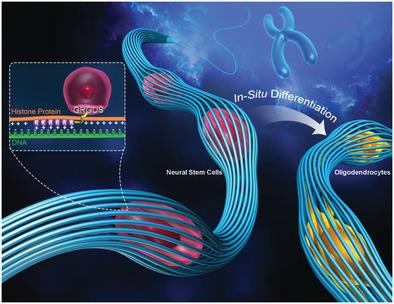当前位置:
X-MOL 学术
›
Adv. Healthcare Mater.
›
论文详情
Our official English website, www.x-mol.net, welcomes your feedback! (Note: you will need to create a separate account there.)
Supramolecular Nanofibers for Encapsulation and In Situ Differentiation of Neural Stem Cells.
Advanced Healthcare Materials ( IF 10.0 ) Pub Date : 2019-11-20 , DOI: 10.1002/adhm.201901295 Hao Zhao 1, 2 , Jingwen Xu 3 , Ke Peng 1, 2 , Xuancheng Fu 1, 2 , Endong Zhang 1, 2 , Fengting Lv 1 , Libing Liu 1 , Na Zhang 4 , Yilin Wang 4 , Shu Wang 1, 2, 5 , Qi Gu 3, 5, 6
Advanced Healthcare Materials ( IF 10.0 ) Pub Date : 2019-11-20 , DOI: 10.1002/adhm.201901295 Hao Zhao 1, 2 , Jingwen Xu 3 , Ke Peng 1, 2 , Xuancheng Fu 1, 2 , Endong Zhang 1, 2 , Fengting Lv 1 , Libing Liu 1 , Na Zhang 4 , Yilin Wang 4 , Shu Wang 1, 2, 5 , Qi Gu 3, 5, 6
Affiliation

|
Design and fabrication of fibrous materials by natural biological macromolecules in light of biomimetics to achieve spatially cellular arrangements are highly desirable in tissue engineering. Herein, chromatin-inspired supramolecular fibers formed through the interfacial polyelectrolyte complexation (IPC) process by DNA and histone proteins for encapsulation and in situ differentiation of murine brain-derived neural stem cells (NSCs) are reported. High cell viability of encapsulated NSCs demonstrates the excellent biocompatibility of fibers as 3D scaffolds. Moreover, a cell-adhesive peptide (K6 -PEG-RGD) is introduced into fibers by electrostatic interaction to improve NSCs encapsulation efficiency and prevent them from migrating out of fibers for enhanced spatially cellular arrangement. In situ differentiation of NSCs into oligodendrocytes within fibers is revealed by immunocytochemical staining assay. Due to the robust abilities to encapsulate and in situ differentiate NSCs, these chromatin-inspired supramolecular fibers show great potential in neural system-related tissue.
中文翻译:

超分子纳米纤维的神经干细胞的封装和原位分化。
在组织工程学中,非常需要根据仿生物通过天然生物大分子设计和制造纤维材料以实现空间细胞排列。在本文中,报道了通过DNA和组蛋白的界面聚电解质络合(IPC)过程形成的染色质启发性超分子纤维,用于鼠脑源性神经干细胞(NSC)的封装和原位分化。封装的NSC的高细胞生存能力证明了纤维作为3D支架具有出色的生物相容性。此外,通过静电相互作用将细胞粘附肽(K6-PEG-RGD)引入纤维中,以提高NSC的包封效率,并防止它们从纤维中迁移出来,从而增强空间细胞的排列。通过免疫细胞化学染色测定揭示了NSCs在纤维内的少突胶质细胞的原位分化。由于封装和原位分化NSC的强大能力,这些受染色质启发的超分子纤维在神经系统相关组织中显示出巨大潜力。
更新日期:2020-01-08
中文翻译:

超分子纳米纤维的神经干细胞的封装和原位分化。
在组织工程学中,非常需要根据仿生物通过天然生物大分子设计和制造纤维材料以实现空间细胞排列。在本文中,报道了通过DNA和组蛋白的界面聚电解质络合(IPC)过程形成的染色质启发性超分子纤维,用于鼠脑源性神经干细胞(NSC)的封装和原位分化。封装的NSC的高细胞生存能力证明了纤维作为3D支架具有出色的生物相容性。此外,通过静电相互作用将细胞粘附肽(K6-PEG-RGD)引入纤维中,以提高NSC的包封效率,并防止它们从纤维中迁移出来,从而增强空间细胞的排列。通过免疫细胞化学染色测定揭示了NSCs在纤维内的少突胶质细胞的原位分化。由于封装和原位分化NSC的强大能力,这些受染色质启发的超分子纤维在神经系统相关组织中显示出巨大潜力。



























 京公网安备 11010802027423号
京公网安备 11010802027423号